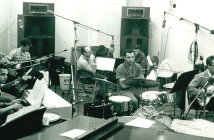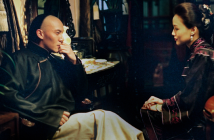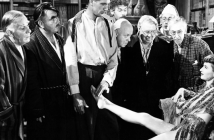
Young Frankenstein (1974)
Cast: Gene Wilder, Madeline Kahn, Marty Feldman
Directors: Mel Brooks
Country: USA
Genre: Comedy
Editor’s Notes: The following review is part of our coverage for TIFF’s Mel Brooks: It’s Good to Be the King. For more information on upcoming TIFF film series visit http://tiff.net and follow TIFF on Twitter at @TIFF_NET.
Pitched as “The Scariest Comedy of All Time!” Mel Brooks’ Young Frankenstein (1974) spoofed the glorious Universal Horror flicks of the 1930s, while at the same time celebrating them. Not just a parody of the original Frankenstein (1931), Young Frankenstein is also based on the sequel The Bride of Frankenstein (1935), as well as the lesser-seen Son of Frankenstein (1939). Son of Frankenstein was a spoof in its own right, starring Karloff once again in the role that made him famous, plus a deliciously unhinged Bela Lugosi as Ygor and a game Basil Rathbone as the son of the original Dr. Frankenstein. Young Frankenstein, in turn, is presumably about Basil Rathbone’s son.
The brainchild of Gene Wilder with a script co-written by Mel Brooks,Young Frankenstein succeeds as a parody in part because of the great care taken to recreate the look of 1930s cinema.
Frederick Frankenstein (Gene Wilder) is an intense, gifted professor of medicine, with a glamorous fiancée (Madeline Kahn) and a good life. But he is haunted by a family legacy he cannot escape, especially after it comes calling in the form of Herr Falkstein (Richard Haydn), an envoy from Transylvania, trying to give the recently discovered will of a long-ago ancestor to its rightful heir. Begrudgingly, Frederick returns to the old home country, only to discover that his grandfather might not have been so crazy after all.
 The brainchild of Gene Wilder with a script co-written by Mel Brooks,Young Frankenstein succeeds as a parody in part because of the great care taken to recreate the look of 1930s cinema. The machinery created by legendary electrical special effects wizard Kenneth Strickfaden for the original Frankenstein was brought out of storage for the film. Life-sized castle and rooftop sets were constructed, and authentic antique medical tomes filled the castle shelves. Cinematographer Gerald Hirschfeld, responsible for the gorgeous black and white photography of films such as Fail-Safe (1964) and The Incident (1967), captures the look of the 1930s, including iris and vertical scene wipes.
The brainchild of Gene Wilder with a script co-written by Mel Brooks,Young Frankenstein succeeds as a parody in part because of the great care taken to recreate the look of 1930s cinema. The machinery created by legendary electrical special effects wizard Kenneth Strickfaden for the original Frankenstein was brought out of storage for the film. Life-sized castle and rooftop sets were constructed, and authentic antique medical tomes filled the castle shelves. Cinematographer Gerald Hirschfeld, responsible for the gorgeous black and white photography of films such as Fail-Safe (1964) and The Incident (1967), captures the look of the 1930s, including iris and vertical scene wipes.
While the look may be vintage, the script is decidedly not. Unlike its predecessors, Young Frankenstein hardly focuses on the true nature of the monster (Peter Boyle), who is, it should be said, mostly a sight gag, with almost no character development save garnering a sex life and learning a little vaudevillian soft-shoe. Both important skills, to be sure, but hardly comparable to the character arcs of the rest of the cast. When we meet Frederick, he wants to distance himself so much from his family’s infamous legacy that he has changed the pronunciation of his name to the very silly “Fron-ken-steen.” After he travels back to Transylvania and studies his grandfather Victor’s research, he undergoes a transformation, embracing his ancestry with an unhinged zeal that identifies him as a true Frankenstein.
There’s a real heart to Young Frankenstein, too, as Frederick genuinely cares about and believes in the monster.
His own quest for identity seems almost contagious, beginning with his assistant Igor (a completely bonkers Marty Feldman) changing the pronunciation of his name to “Eye-gor,” mostly out of spite. Though Igor is the source of the most outrageous (and hilarious) plot complications, it would be a mistake to dismiss the character as merely Puckish. Igor practically blossoms as the film progresses, where he, much like the monster, starts off as a sight gag and narratively convenient source of stupidity, then works his way up in both intelligence and usefulness, all while the disfiguring hump on his back moves about just enough to be upsetting.
Frederick’s fiancée Elizabeth grows as a character, too, starting out as the good doctor’s impossibly glamorous and brittle girlfriend, inevitably exchanging her pleasant and convenient love of Frederick for a perverse (and sexy) relationship with the monster. As the lives of those who inhabit Young Frankenstein become more bizarre, the happier they get, with the possible exception of the monster who has achieved the comforting banality of a middle class lifestyle, and all the petty annoyances therein.
There’s a real heart to Young Frankenstein, too, as Frederick genuinely cares about and believes in the monster. The early horror genre trope of including scenes of the various monsters — or, more accurately, “monsters” — being put on display is skewered in the famous “Puttin’ on the Ritz” number which, for all its silly fun, shows the young doctor refusing to humiliate his creation. Another shattered trope comes courtesy Cloris Leachman, who is perfection as the hideous Frau Blücher, the stock ugly harridan character; in Young Frankenstein, the harridan turns out to be an intelligent woman with emotion, a woman hurt that the mere mention of her name scares horses, even at great distance. And Kenneth Mars, a stand-out in Brooks’ prior film The Producers (1969), is terrific as Inspector Kemp. Though Kemp is a straight borrowing of Lionel Atwill’s character from Son of Frankenstein — yes, the mechanical arm and the darts gag are original to the 1939 film — Mars gives Atwill a run for his money in sheer grotesquery.
If there is any flaw to be had in Young Frankenstein, it’s the scenes with the blind monk in the woods. Based so heavily on the original scenes from The Bride of Frankenstein that they’re almost just simple re-shoots with a few gags added in, Gene Hackman as the monk is obviously overwhelmed and out of his element. Grinning like a newbie throughout, he’s almost unable to stifle his chuckling. It’s a fatal flaw in a film that only works if everything is played straight. Imagine if Garr, Wilder and Feldman hadn’t been able to speculate on the size of the monster’s schwanzstucker without giggling, or if Leachman couldn’t have declared that Victor was her boyfriend without having to hide a chuckle. That’s how the entire monk sequence plays out, and it’s frustrating, though Hackman is so charming that, if we’re being truly honest with ourselves, we know we will forgive him anything.
Young Frankenstein is a seamless blend of shtick and sentiment. Sure, there are plenty of crude gags and double entendres, yet at the same time, Brooks’ films rarely feature any outright insult to the genres he takes on. Rather, he makes fun of certain Hollywood tropes while reveling in others, all while creating joyous and hilarious and often irreverent films. And if Young Frankenstein isn’t the best film in Mel Brooks’ oeuvre, it’s certainly the film with the best one-liner of his career: “Sedagive?!”
Young Frankenstein is a seamless blend of shtick and sentiment. Sure, there are plenty of crude gags and double entendres, yet at the same time, Brooks' films rarely feature any outright insult to the genres he takes on.



